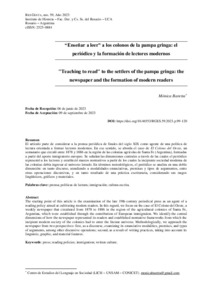Please use this identifier to cite or link to this item:
https://repositorio.uca.edu.ar/handle/123456789/17531| Título: | “Enseñar a leer” a los colonos de la pampa gringa : el periódico y la formación de lectores modernos "Teaching to read" to the settlers of the pampa gringa : the newspaper and the formation of modern readers |
Autor: | Baretta, Mónica | Palabras clave: | PRENSA; POLITICA CULTURAL; LECTURA; CULTURA | Fecha de publicación: | 2023 | Editorial: | Pontificia Universidad Católica Argentina. Facultad de Derecho y Ciencias Sociales del Rosario. Instituto de Historia | Cita: | Baretta, M. “Enseñar a leer” a los colonos de la pampa gringa : el periódico y la formación de lectores modernos [en línea]. Res Gesta. 2023, 59. doi: 10.46553/RGES.59.2023.p.99-120. Disponible en: https://repositorio.uca.edu.ar/handle/123456789/17531 | Resumen: | Resumen: El artículo parte de considerar a la prensa periódica de finales del siglo XIX como agente de una política de lectura orientada a formar lectores modernos. En ese sentido, se aborda el caso de El Colono del Oeste, un semanario que circuló entre 1878 y 1886 en la región de las colonias agrícolas de Santa Fe (Argentina), formadas a partir del aporte inmigratorio europeo. Se señalan las dimensiones centrales a través de las cuales el periódico representó a los lectores y estableció marcos normativos a partir de los cuales la incipiente sociedad moderna de las colonias debía ingresar al universo letrado. En términos metodológicos, el periódico se analiza en una doble dimensión: en tanto discurso, atendiendo a modalidades enunciativas, premisas y tipos de argumentos, entre otras operaciones discursivas, y en tanto resultado de una práctica escrituraria, considerando sus rasgos lingüísticos, gráficos y materiales. Abstract: The starting point of this article is the examination of the late 19th-century periodical press as an agent of a reading policy aimed at cultivating modern readers. In this regard, we focus on the case of El Colono del Oeste, a weekly newspaper that circulated from 1878 to 1886 in the region of the agricultural colonies of Santa Fe, Argentina, which were established through the contribution of European immigration. We identify the central dimensions of how the newspaper represented its readers and established normative frameworks from which the incipient modern society of the colonies had to enter the literate universe. Methodologically, we approach the newspaper from two perspectives: first, as a discourse, examining its enunciative modalities, premises, and types of arguments, among other discursive operations; second, as a result of writing practices, taking into account its linguistic, graphic, and material features. |
Cobertura Espacial: | Argentina | Cobertura Temporal: | SIGLO XIX | URI: | https://repositorio.uca.edu.ar/handle/123456789/17531 | ISSN: | 2525-0884 (online) 0325-772X (impreso) |
Disciplina: | HISTORIA | DOI: | 10.46553/RGES.59.2023.p.99-120 | Derechos: | Acceso abierto | Fuente: | Res Gesta. 2023, 59 |
| Appears in Collections: | RG - 2023 nro. 59 |
Files in This Item:
| File | Description | Size | Format | |
|---|---|---|---|---|
| ensenar-leer.pdf | 323,74 kB | Adobe PDF |  View/Open |
Page view(s)
10
checked on Apr 27, 2024
Download(s)
18
checked on Apr 27, 2024
Google ScholarTM
Check
Altmetric
Altmetric
This item is licensed under a Creative Commons License

